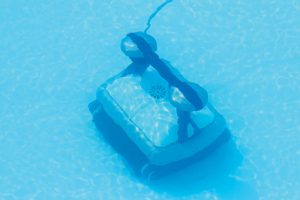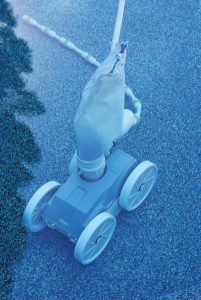The swimming pool cleaner has been around for over one hundred years. These devices owe their evolution to imaginative tinkerers, engineers and designers from all over the world. Like swimming pools, there is almost certainly no single inventor or single swimming pool cleaner that has been recorded in history as the first such machine. However, by tracing key patent records, one can begin to appreciate how these devices, whether suction-side, pressure-side or robotic, developed into the popular swimming pool maintenance products they are today.
A cleaner timeline

Swimming pool cleaners, as the industry knows them now, evolved slowly from a combination of various machines, such as pumps, motors and rotating brush devices.
Swimming pool cleaners, as the industry knows them now, evolved slowly from a combination of various machines, such as pumps, motors and rotating brush devices. The following timeline explains the progression.
Early inventions lead the way
The forerunners of today’s pool cleaners were cistern cleaners. In fact, though a patent was never issued, there are references to a cistern cleaner patent application being filed as early as 1798.
In 1884, however, a patent was finally issued for a ‘cistern and tank cleaner.’ Using a combination of suction and manipulation of water pressure, the device could sweep and scrape the bottom of a cistern or tank to separate and remove sediment without the need to remove any water.
Over the next 20 years, this invention was improved on numerous occasions. In fact, many pool cleaner patents issued in the modern era refer to some of the cistern cleaners as antecedent to the current invention.
Almost 30 years later, a ‘cleaning apparatus for swimming pools’ was designed to collect sediment from the bottoms of swimming tanks without the need to drain any water. A patent for this device was issued in 1912 to John M. Davidson of Pittsburgh, Penn., who rightly deserves credit as the inventor of the early swimming pool cleaner. However, there is no readily available evidence that shows the product was ever commercially produced or manufactured.
Fifteen years would pass before another ‘viable’ patent was issued. In 1937, a patent was filed for a machine that resembles the modern-day pool cleaner—brushes and all.
The 1950s: Three important steps
Three key developments occurred during this decade. The first, in 1953, was the invention of a device that resembled a typical upright vacuum cleaner. In addition to being inexpensive to the manufacturer, the cleaner’s primary claim to fame was its light weight and ease of handling. It was also suction-side driven, could be operated via a standard garden hose and did not require outside electrical power. Another key development occurred in 1955 when a patent was filed for a ‘submarine suction cleaner.’ This is possibly the most referenced antecedent device in later patents, as it operated in much the same way as a robotic pool cleaner. It was designed to navigate the pool floor and even had its own self-contained suction motor. Technically, this cleaner comprised a pump, which filtered discharged water and sediment out of the pool. Where filtering equipment was available, the water from the discharge hose could be filtered and returned to the pool.
The following year, a leaf vacuum was invented, which claimed to remove leaves from the pool. In fact, this device could quite easily be confused with one of today’s commercial leaf vacuums.
The final breakthrough of the decade occurred in 1958, when Andrew L. Pansini, founder of Jandy, made an indelible mark in the pool industry by inventing a new automatic pool cleaner. It operated via a water hose attachment and the pool’s main pump and filter system to direct the flow of water, driving debris towards the pool’s main drain.
The 1960s: Advancements continue
Progression of the pool cleaner continued when, in 1960, a patent application for a pool cleaner resembling a hand-held floor polisher was submitted. Although the device was patented three years later, this cleaner does not appear to have had any commercial impact.

Typical pressure-side pool cleaners operate via a secondary booster pump. This high pressure water propels the cleaner and provides debris suction via Venturi action.
This development period also witnessed what is quite possibly the precursor to today’s robotic electric pool cleaners, the Aqua Queen by AquaVac Systems in West Palm Beach, Fla., in the early 1960s. Said to weigh more than 18 kg (40 lbs), this bulky automated device used a self-contained pump, motor and filter system to vacuum the pool as it travelled from wall to wall. No patent was discovered to have been applied for or issued to this machine.
A wave of suction-side cleaners also started to appear in the 1960s. Perhaps the most famous of these devices was patented in 1965, the Arneson Pool Sweep. This cleaner comprised a central unit with tentacle-like extrusions, which roamed all over the pool. As complex as it seems, the fact it not only worked but became an industry icon is clearly a tribute to the engineering skill of its designer. It is also the likely forerunner to the current-day pressure-side cleaner.
The 1970s: A defining era
During this decade, major turning points were achieved for all three main types of cleaners (suction-side, pressure-side and robotic). In terms of robotics, numerous powered pool cleaner patent applications, dating back to 1967, were submitted, leading to the 1971 patent for a complex electric pool cleaning machine.
This device used numerous sensors, levers and shafts to collect debris in an onboard bag. Although the debris bag was not contained within the body of the device, it may be the first to truly qualify as an electric robotic cleaner.
The progenitor for many of today’s pressure-side cleaners likely evolved from a design that was patented in 1974 by Melvyn L. Henkin, a resident of Los Angeles’ San Fernando Valley. It was to become perhaps the most famous of all pool cleaners, the Polaris. The cleaner’s three-wheel configuration, combined with Venturi action, allowed the unit to easily move along the pool floor, collecting debris in its filter bag along the way.
A groundbreaking suction-side cleaner design was patented in 1977. The device, which resembles a large metal detector, connects to a vacuum line on the side of the pool and uses suction provided by the pool’s pump to move forward along the pool’s floor and walls.
Suction-side cleaners remain the mainstay of the swimming pool cleaner industry. Manufacturers that offered early versions of these cleaners—although varied in design and function—all helped grow the pool cleaner industry, which is why they are still the choice for the majority of pool owners who opt for an automatic pool cleaner.
Finally, in 1979, a patent was issued that served as the basis for many robotic pool cleaners at that time. The progeny of these inventions was a growing line of residential and commercial products that have dominated the robotic pool cleaner market for the last three decades. These continue to be the most technologically advanced pool cleaner designs in the world.
The 2000s: Technology moves forward
In 2004, a battery-powered hand-held pool and spa cleaner was patented by New Jersey’s Guy Erlich. This device uses an onboard, high-quality, nickel-metal hydride rechargeable battery and houses a filter and impeller attached to an electric motor within its body. Key features of this design include ease of maintenance and portability, as the cleaner does not require hoses, power cords or booster pumps to operate.
Conclusion
While the patented pool cleaners mentioned in this article may have never become commercially feasible, they all contributed to the evolution of the modern pool cleaner market. Those that were viable became industry icons. As a result, today there is a cleaner or vacuum for every pool, spa/hot tub and budget.
This article was written by Richard K. Cacioppo, Sr. J.D, and originally appeared on Pool & Spa Marketing [link].
